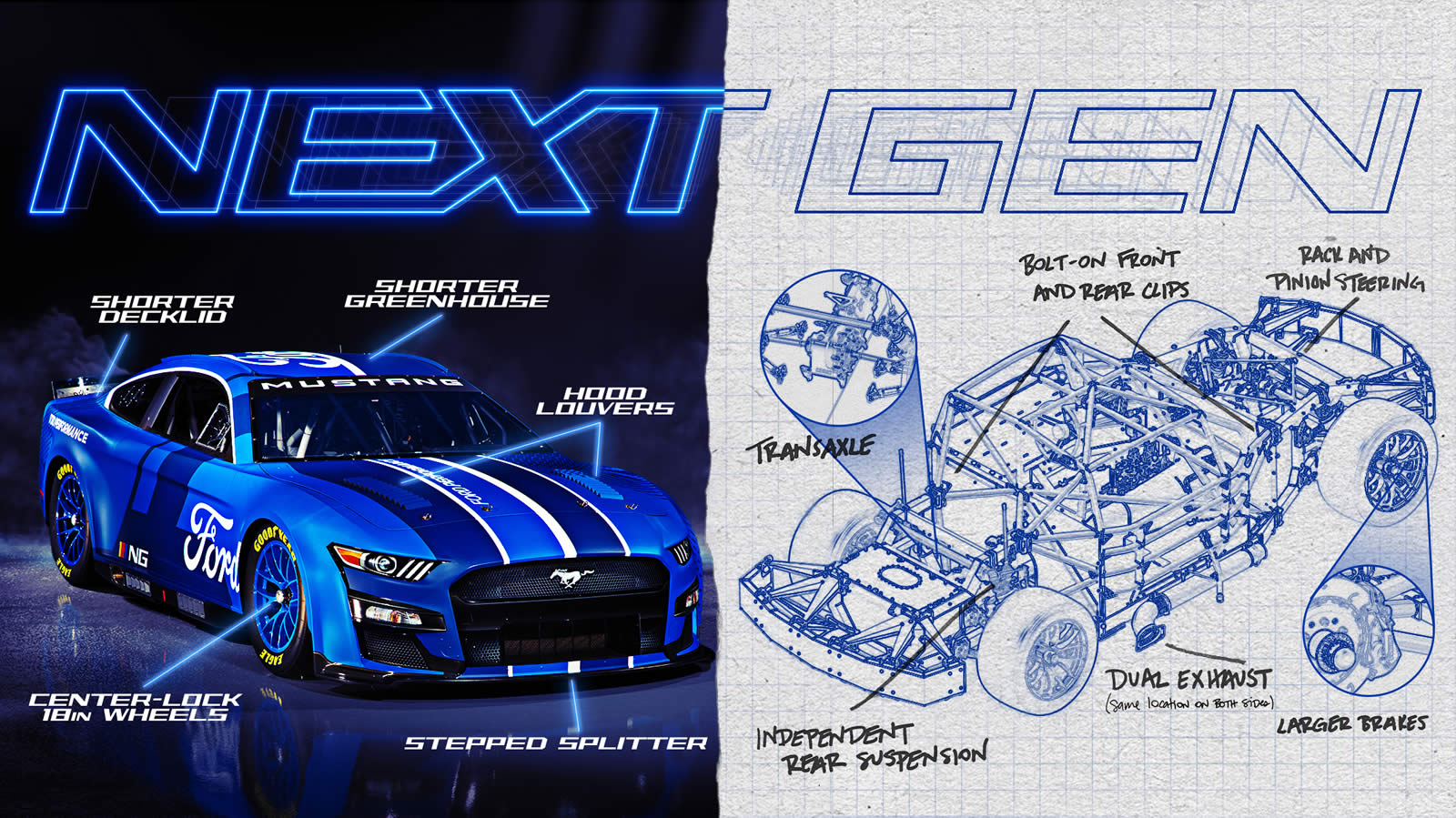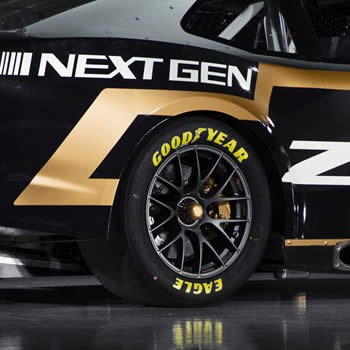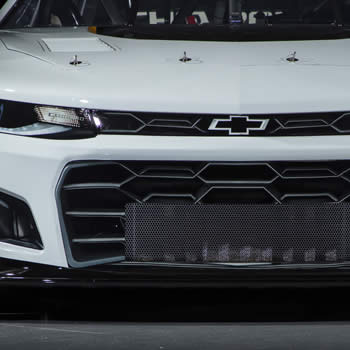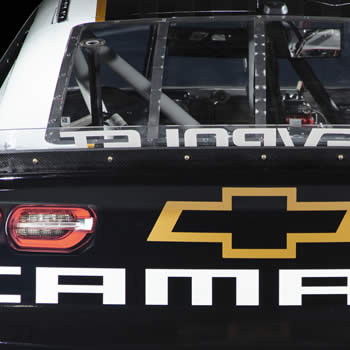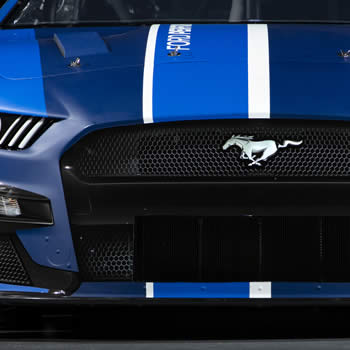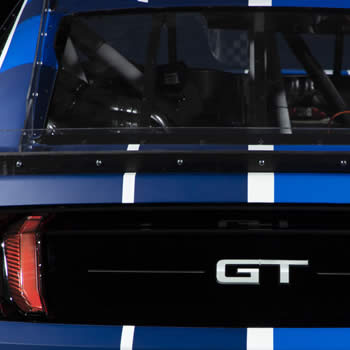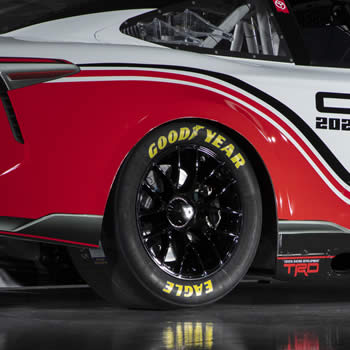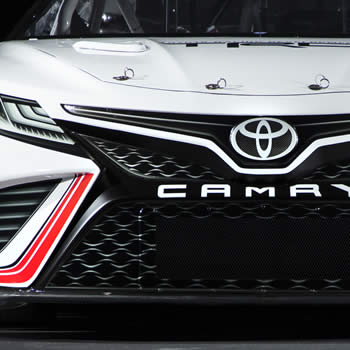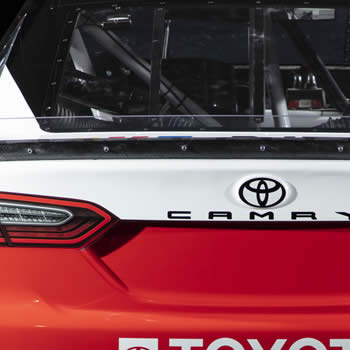NASCAR Cup Series
NEXT GEN Car
2022 NASCAR Season
The NASCAR NEXT GEN car allows each manufacturer to incorporate features into the race car body that better replicate the look and feel of the street car.
NEXT GEN CHEVROLET
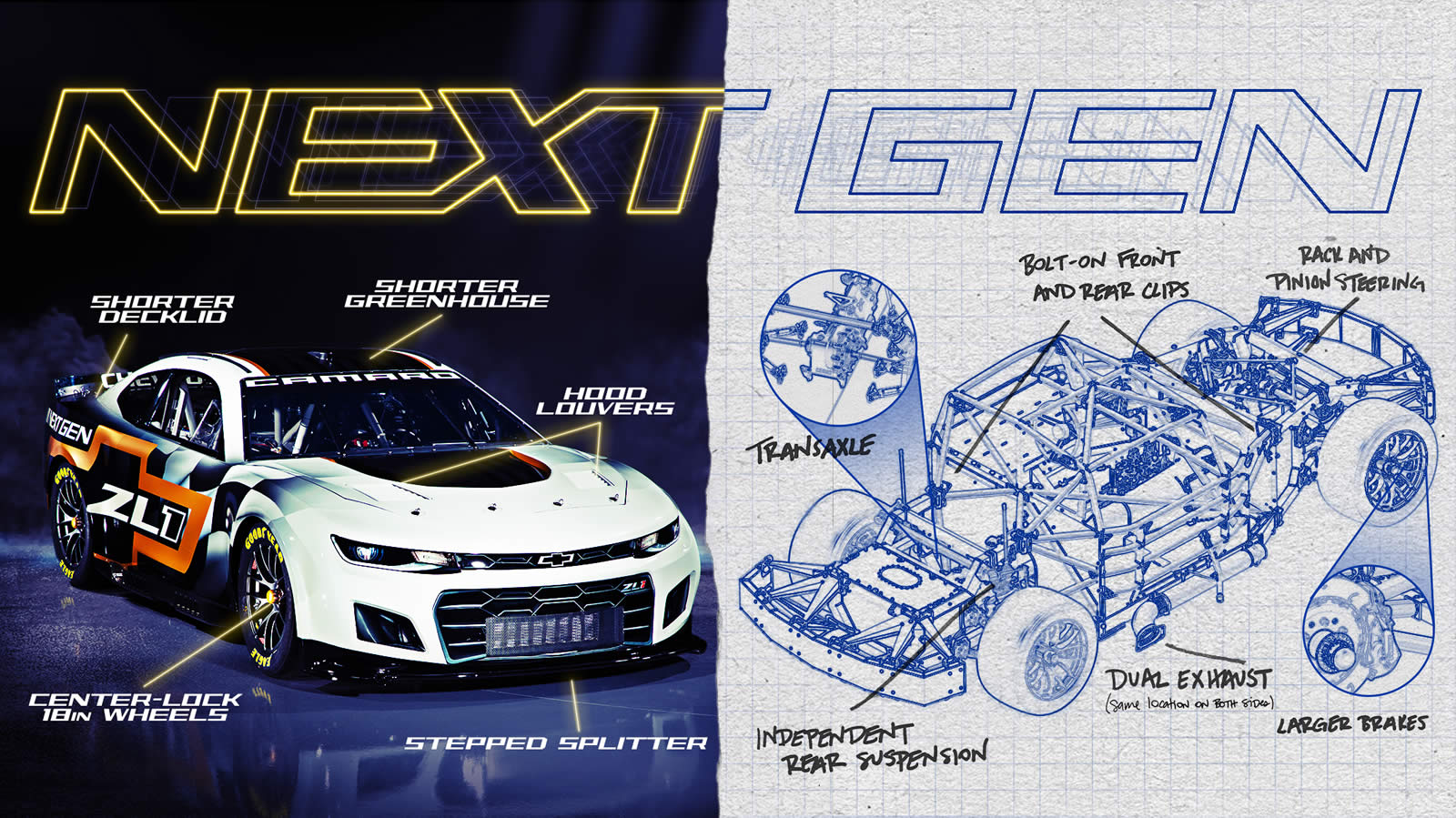
NEXT GEN TOYOTA

NEXT GEN STYLING
- A sleek new design has lowered the greenhouse, shortened the deck lid and widened the track width of the car giving it more of a coupe look.
- The body is fully symmetrical which will reduce aerodynamic forces and put an emphasis back on race car setup and driver control. The new composite material is more durable and will allow more beating and banging without loss of performance.
- New 18" forged aluminum wheels and wider Goodyear tires better replicate what is found on passenger cars and will allow for softer tire compounds.
NEXT GEN COMPONENTS
- Upgraded specs to match modern passenger vehicle technology including independent rear suspension, rack and pinion steering and larger brakes.
- A new transaxle combines the transmission and rear gears into one package with an eye on the future - the ability to incorporate electrification.
- The bottom of the car is sealed with an underwing and rear diffuser which will help with handling in traffic and reduce 'dirty air.'
- Hood louvers will allow teams to maximize engine performance independent of aerodynamics.
- A redesigned chassis features new front and rear bumpers for increased safety. Both the front and rear clips bolt on to the center section for easier serviceability and damage repair.
- Upgraded car connectivity will allow for an in-car camera in every vehicle, with the ability to bring fans more real-time data in the future.
NEXT GEN SPECS
- Length: 193.4"
- Width: 78.6"
- Height: 50.4"
- Wheelbase: 110"
- Weight: ~ 3,300 lbs
- Spoiler: TBD*
- Body: Composite symmetric body featuring integral flap systems, camera mounts and OEM-specific design elements
- Underwing: Full carbon undertray w/center stepped splitter and rear diffuser
- Chassis: Steel tubing w/bolt-on front and rear clips and front/rear bumpers
- Transaxle: 5-speed manual sequential with ramp and plate differential
- Suspension (Front and rear): Double wishbone billet aluminum control arms w/adjustable coil over shock absorbers
- Steering: Rack and pinion
- Wheels: 18" x 12" forged aluminum
- Tires: Goodyear Eagle
- Brakes: Six piston monobloc front calipers / four piston monobloc rear calipers – heavy duty and light duty disc packages
- Front Brake Rotors: 15"
- Rear Brake Rotors: 14"
- Engine displacement: 358 cu in
- Induction system: Naturally aspirated
- Fuel system: Fuel injection
- Oil system: Dry sump
- Horsepower: TBD*
- Engine cooling: Air exits radiator through hood louvers
- Exhaust: Split-side exit exhaust
- Fuel cell: ~20 gallons (Sunoco Green E15)
* Race package elements to be finalized based on track type and size
NEXT GEN VENDORS
- Aero Tec Laboratories, Inc. - Fuel cell bladder
- AP Racing Limited - Brake systems
- Bald Spot Sports - Energy management solutions (bumper and door foam)
- BBS of America, Inc. - Wheels
- Dallara - Radiator ducts
- Fibreworks Composites, LLC - Deck lid, hood, rockerbox cooling ducts, underwing
- Five Star Race Car Bodies - Doors, fenders, front/rear bumper covers, fuel adapter, quarter panels, rear door crush panel, rear wheel tubs, windows
- Goodyear - Tires
- Hyperco - Springs
- Kirkey Racing Fabrication Bumpers
- Lentus Composites Limited Propshaft
- McLaren - Digital dash, ECU
- Ohlins USA, Inc. - Dampers
- Pro-Fabrication, Inc. - Tailpipes
- PWR North America - Oil cooler, radiator
- RCR Manufacturing Solutions, LLC - Wheel nut
- Roush Advanced Composites - Greenhouse, brake ducts (upright / rotor), front door crush panels, front wheel exhaust cover, package tray, roof hatch, roof flaps, spoiler base
- Roush Yates Manufacturing Solutions - Anti-roll bars, shifter, transaxle mounts, uprights / wheel hubs
- Schultz Engineered Products - Fuel adaptor / coupler
- Sunoco - Fuel
- Technique Chassis, LLC - Chassis: front / center / rear, body mounts
- Thermal Control Products - Fixed window net / driver window net / assemblies
- Tilton Engineering, Inc. - Bell housing
- Visser Precision, LLC - Control arms (front / rear)
- Woodward Machine Corporation - Steering rack, steering shaft
- Xtrac Inc. - Clutch shaft, driveshafts, transaxle
NEXT GEN PHOTO GALLERY
CHEVROLET NEXT GEN Car
The 2022 NASCAR Next Gen Chevrolet Camaro is previewed at NASCAR R&D Center on April 22, 2021 in Concord, North Carolina. (All Photo Credit: Jared C. Tilton | Getty Images)
FORD NEXT GEN Car
The 2022 NASCAR Next Gen Ford Camry is previewed at NASCAR R&D Center on April 22, 2021 in Concord, North Carolina. (All Photo Credit: Jared C. Tilton | Getty Images)
TOYOTA NEXT GEN Car
The 2022 NASCAR Next Gen Toyota Camry is previewed at NASCAR R&D Center on April 22, 2021 in Concord, North Carolina. (All Photo Credit: Jared C. Tilton | Getty Images)
NEXT GEN MANUFACTURERS PRESS RELEASES
CHEVROLET Press Release
Track and Street Come Closer Together in the All-New Chevrolet NASCAR Next Gen Camaro ZL1 Race Car
CHARLOTTE, N.C. – Chevrolet and other major automotive brands competing in the NASCAR Cup Series revealed their Next Gen models today. Chevrolet's new look on the racetrack will more closely connect to its cars in the showroom when Chevy campaigns its Next Gen Camaro ZL1 race car starting next season in the NASCAR Cup Series. The new look and features are a result of a collaborative effort by Chevrolet, the series and other original equipment manufacturers for race cars competing at the Cup level to look and perform more like their production counterparts.
The Next Gen Camaro ZL1 race car's new lower greenhouse, shortened deck lid and widened track width contribute to a coupe-like appearance. A fully symmetrical body design makes the race car look even more like the production Camaro.
"Chevrolet engineers and designers worked alongside our race teams to develop this race car while staying true to the styling essence of the Camaro ZL1," said Jim Campbell, GM U.S. vice president of Performance and Motorsports. "This cooperation will benefi1t Chevrolet both on the track and the street."
Both the Next Gen Camaro ZL1 race car and production Camaro ZL1 offer hood air extractors that enhance track performance.
"The Next Gen Camaro has a much stronger link to the production Camaro ZL1 in terms of styling integration, improved proportions and relevant technologies," said Eric Warren, Chevrolet director of NASCAR Programs. "From an engineering standpoint, this is a seismic shift. It's a completely new car that brings with it a lot of opportunity from a technical standpoint."
Other changes to the 2022 Next Gen race car include:
- Upgraded specs to match modern passenger vehicle technology, including independent rear suspension – like production Camaros – and rack and pinion steering.
- An increase in wheel size from 15 to 18 inches. The larger diameter wheels allow for larger brakes for improved track performance. Wheels will be made from forged aluminum, like the wheels on the production Camaro ZL1.
- A new transaxle that combines the transmission and rear gears into one package.
- The bottom of the car will be sealed with an underwing and rear diffuser for enhanced aerodynamics.
- A redesigned chassis features new front and rear bumpers with an energy-management system.
- Both the front and rear clips bolt on to the center section for easier serviceability and damage repair.
Chevrolet initially introduced the Camaro ZL1 race car to NASCAR Cup competition in 2018. It was replaced by the Camaro ZL1 1LE race car in 2020, which Chase Elliot drove to a Driver's Championship in the car's first season.
Chevrolet has campaigned 14 different nameplates in the Cup Series, dating back to 1955, and with 798 victories is the winningest brand in NASCAR Cup Series history. Chevy's first win was by Fonty Flock at Columbia Speedway in South Carolina in 1955, the same year Chevrolet introduced its famed small-block V-8. Since then, Chevrolet has won 39 Manufacturer Championships, including 13 in a row from 2003-2015, and 32 Driver Championships to lead all manufacturers.
The Next Gen Camaro ZL1 race car will make its points-paying debut at next season's Daytona 500 at Daytona International Speedway in Daytona Beach, Florida on Feb. 20, 2022.
ABOUT CHEVROLET
Founded in 1911 in Detroit, Chevrolet is now one of the world's largest car brands, available in 79 countries with more than 3.2 million cars and trucks sold in 2020. Chevrolet models include electric and fuel-efficient vehicles that feature engaging performance, design that makes the heart beat, passive and active safety features and easy-to-use technology, all at a value. More information on Chevrolet models can be found at www.chevrolet.com.
FORD Press Release
World's best-selling sports car remains Ford's entry in America's most popular form of auto racing
DEARBORN, MICHIGAN - A completely new era in stock car racing is ushered in today as Ford unveils its all-new 2022 NASCAR Next Gen Mustang to the public in Charlotte, North Carolina. The Next Gen Mustang will compete in the NASCAR Cup Series starting next season.
The new car, which has been under development for two years, is completely different from its predecessor – redesigned from the ground up. Unlike past versions, with the exterior being the only noticeable change, this model is built for the future, featuring flexibility for technological advances such as a hybrid or electric powertrain.
The new race car more closely mirrors its Mustang production counterpart, which maintains its title as world's best-selling sports car.
"A lot of work has been done behind the scenes to make sure this Next Gen Mustang remains relevant to our customers," said Mark Rushbrook, global director, Ford Performance Motorsports. "As the automotive industry continues to change, we'll have the ability to keep up in the racing world without having to go through a complete overhaul or redesign of the car. This is something we've been waiting for and we're glad the time has finally arrived."
Changes include rack-and-pinion steering, independent rear suspension and 18-inch tires with aluminum forged wheels. The all-new body features a wider stance, while a symmetric exterior shell, tail and smaller greenhouse area closely resemble the production Mustang.
"This car is true to the Mustang brand and we have to thank the Ford design team for working hand-in-hand with our aerodynamic engineers to ensure it is competitive on the track, while maintaining unique Mustang styling," said Rushbrook. "That requires a lot of give-and-take on both sides, but with the new smaller greenhouse area and shorter rear deck, we were able to do a lot of things to make sure there's no mistaking this is a Mustang."
Development of the new car took place both in Ford's Dearborn design center and at the Ford Performance Technical Center in Concord, North Carolina, where Ford's NASCAR scale model and aero teams are located. Extensive development continues on full-motion simulators at the technical center, where both racing and production car work takes place.
"Mustang is an iconic brand for Ford and when I saw the Next Gen Mustang in person for the first time I was pumped," said Team Penske driver Joey Logano, the 2018 NASCAR Cup Series champion. "The aggressive look of the nose and the changes to the greenhouse and tail make the car more authentic to the street Mustang than ever before. I know the fans are going to love the Next Gen Mustang and I can't wait to get it on the track."
Mustang came to the NASCAR Cup Series in 2019 and has won at least 10 races each of its first two years, including a season-high 18 victories in 2020 that helped Ford win the manufacturers' championship.
The NASCAR Next Gen Mustang makes its competition debut on Feb. 20, 2022, at Daytona International Speedway for the 64th annual Daytona 500.
To learn more about Mustang, please visit Ford.com/Mustang.
ABOUT FORD MOTOR COMPANY
Ford Motor Company (NYSE: F) is a global company based in Dearborn, Michigan. The company designs, manufactures, markets and services a full line of Ford trucks, utility vehicles, and cars – increasingly including electrified versions – and Lincoln luxury vehicles; provides financial services through Ford Motor Credit Company; and is pursuing leadership positions in electrification; mobility solutions, including self-driving services; and connected vehicle services. Ford employs approximately 186,000 people worldwide. For more information regarding Ford, its products and Ford Motor Credit Company, please visit corporate.ford.com.
TOYOTA Press Release
As NASCAR Introduces Next Gen, Toyota Adds TRD Camry to Nameplate
CHARLOTTE, N.C. - More than two years in the making, Toyota and TRD (Toyota Racing Development) today unveiled the manufacturer's Next Gen car that will take to the track in 2022 – the Toyota TRD Camry – in the NASCAR Cup Series (NCS).
Toyota has been working alongside NASCAR, as well as the other OEMs, on the development of the Next Gen vehicles for competition. The components of the Next Gen race cars are an unprecedented move for the sport, but one that looks to continue to evolve safety enhancements of the race cars and promote on-track competition.
Toyota, TRD (Toyota Racing Development, U.S.A.) and Calty Design have worked together to ensure as many body styling characteristics as possible are incorporated into the Toyota TRD Camry Next Gen so it resembles its production counterpart as closely as possible. From the grille to the spoiler and everywhere in between, the Next Gen TRD Camry race car has the most body styling attributes to its production counterpart than ever before in a NCS Camry. This is a practice that Toyota and TRD have employed since the development of the 2013 Camry in NCS competition.
"There has been a substantial amount of work put into the Toyota TRD Camry Next Gen car by all of our partners, but specifically everyone at TRD and Calty Design," said Paul Doleshal, group manager of motorsports and assets, TMNA (Toyota Motor North America). "We're thrilled to have the chance to showcase the TRD Camry to represent Toyota in the NASCAR Cup Series through this Next Gen project. This is our topline, track-inspired performance Camry and it seemed only fitting for it to take it's spot on the race track."
Toyota continues to be the only manufacturer in NASCAR to showcase three nameplates across NASCAR's three national series – the TRD Camry in the NCS, the Supra in the NASCAR Xfinity Series (NXS) and the Tundra in the NASCAR Camping World Truck Series (NCWTS). Since joining the NCS and NXS in 2007, Camrys have earned 155 NCS wins and three NCS championships along with 171 NXS wins and two NXS championships. And since Tundra's entry into the NCWTS in 2004, Toyota has claimed 204 victories and eight Truck Series championships.
"For Toyota and TRD, we're committed to the principle of continuous improvement and we believe that's reflected in this Next Gen TRD Camry," said David Wilson, president of TRD. "While we know the margins available with this new race car are smaller when it comes to adjustability, we know our race team partners and our team at TRD look forward to the challenge of learning about this car and discovering the performance opportunities that will help put the TRD Camry into victory lane."
The Toyota TRD Camry Next Gen will make its debut as the 2022 NASCAR Cup Series season kicks off at Daytona International Speedway on Sunday, February 20, 2022.
ABOUT TOYOTA
Toyota (NYSE:TM) has been a part of the cultural fabric in the U.S. and North America for more than 60 years, and is committed to advancing sustainable, next-generation mobility through our Toyota and Lexus brands. During that time, Toyota has created a tremendous value chain as our teams have contributed to world-class design, engineering, and assembly of more than 40 million cars and trucks in North America, where we have 14 manufacturing plants, 15 including our joint venture in Alabama (10 in the U.S.), and directly employ more than 47,000 people (over 36,000 in the U.S.). Our 1,800 North American dealerships (nearly 1,500 in the U.S.) sold nearly 2.8 million cars and trucks (nearly 2.4 million in the U.S.) in 2019.
Through the Start Your Impossible campaign, Toyota highlights the way it partners with community, civic, academic and governmental organizations to address our society's most pressing mobility challenges. We believe that when people are free to move, anything is possible. For more information about Toyota, visit www.toyotanewsroom.com.
